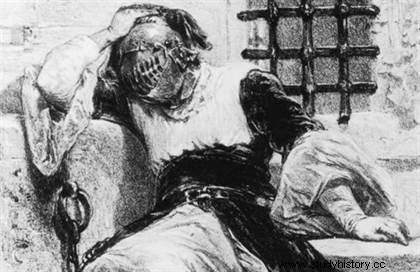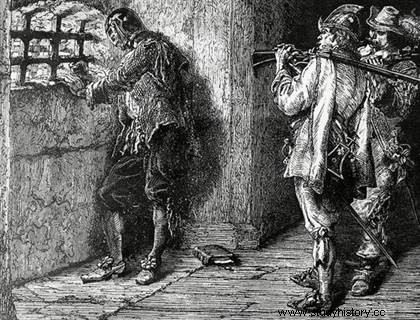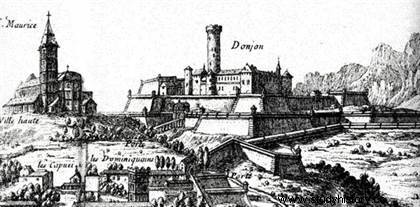 The Iron Mask, died in the Bastille in 1703, is the most famous and mysterious of French prisoners, his true identity having been the subject of much speculation. In Le Siècle de Louis XIV, a work published in 1754, Voltaire was the first to mention the affair of the Iron Mask. Wearing a velvet mask with metal joints, he was first locked up by order of Louis XIV in 1679 in Pignerol, in Piedmont, then in the Château d'If, on the island of Sainte-Marguerite. In 1698, the Iron Mask was brought to the Bastille, where he died in 1703. Little is known about this unknown man. His true identity was the subject, from the outset, of many hypotheses, many of which have been abandoned.
The Iron Mask, died in the Bastille in 1703, is the most famous and mysterious of French prisoners, his true identity having been the subject of much speculation. In Le Siècle de Louis XIV, a work published in 1754, Voltaire was the first to mention the affair of the Iron Mask. Wearing a velvet mask with metal joints, he was first locked up by order of Louis XIV in 1679 in Pignerol, in Piedmont, then in the Château d'If, on the island of Sainte-Marguerite. In 1698, the Iron Mask was brought to the Bastille, where he died in 1703. Little is known about this unknown man. His true identity was the subject, from the outset, of many hypotheses, many of which have been abandoned.
The man in the iron mask, a mysterious prisoner
This mysterious character was imprisoned in the fortress of Pignerol in Piedmont from 1680 where he always remained under the care of M. de Saint-Mars. He then stayed at the fortress of Île Sainte-Marguerite (Lérins) from 1687 to 1698, then the Bastille, where he arrived on September 18, 1698 and died there on November 19, 1703. Until the end of his days, he was forced to wear a velvet mask with iron joints.
For the rest, it was very well handled. When he died, he was buried under the name of Marchiali in the Saint-Paul cemetery and all the objects he had used were immediately burned. They had the walls of the room he had occupied scraped and whitewashed, and the tiles were removed to see if he had not hidden some message there. The pages of the Bastille registers concerning him were torn out.
But who was the iron mask?
 From the 18th century, the public began to be passionate about the identity of the Man in the Iron Mask . Among the hypotheses put forward and now abandoned, let us quote:the ex-superintendent of Finances Fouquet, who died officially at the beginning of 1680; Louis de Bourbon, Comte de Vermandois, natural son of Louis XIV and Madame de La Vallière, born in 1667 and legitimized in 1669, and who disappeared from court and from the world in 1683; an elder half-brother of Louis XIV, born of adulterous relations of Anne of Austria (hypothesis formulated for the first time by Voltaire and taken up by Alexandre Dumas father in his novel Le Vicomte de Bragelonne); a son born of a secret marriage of Anne of Austria with Cardinal de Mazarin; the Duc de Beaufort, officially dead at the siege of Candie in 1669; a nephew of James II of England, the Duke of Monmouth. who would have been thus rescued from punishment after his revolt; R. P. Jacques de La Cloche, natural son of Charles II of England, who had been aware of the secret Treaty of Dover concluded between his father and Louis XIV; Molière, victim of revenge by devotees following his Tartuffe...
From the 18th century, the public began to be passionate about the identity of the Man in the Iron Mask . Among the hypotheses put forward and now abandoned, let us quote:the ex-superintendent of Finances Fouquet, who died officially at the beginning of 1680; Louis de Bourbon, Comte de Vermandois, natural son of Louis XIV and Madame de La Vallière, born in 1667 and legitimized in 1669, and who disappeared from court and from the world in 1683; an elder half-brother of Louis XIV, born of adulterous relations of Anne of Austria (hypothesis formulated for the first time by Voltaire and taken up by Alexandre Dumas father in his novel Le Vicomte de Bragelonne); a son born of a secret marriage of Anne of Austria with Cardinal de Mazarin; the Duc de Beaufort, officially dead at the siege of Candie in 1669; a nephew of James II of England, the Duke of Monmouth. who would have been thus rescued from punishment after his revolt; R. P. Jacques de La Cloche, natural son of Charles II of England, who had been aware of the secret Treaty of Dover concluded between his father and Louis XIV; Molière, victim of revenge by devotees following his Tartuffe...
A more recent hypothesis has identified the Man in the Iron Mask with Marc de Jarrige de La Morelhie, son-in-law of the doctor who carried out the autopsy of Louts XIII and who would have surrendered realized that the king was incapable of being a father.
A diplomat? A servant of Fouquet?
More serious are the assumptions about Mattioli and Dauger. According to the first, Ercole Mattioli, secretary of Ferdinand Charles, Duke of Mantua, had been charged, in 1678, with the negotiation of a treaty by which the Duke, pressed by financial needs, abandoned the fortress of Louis XIV to Louis XIV. Casai against an indemnity of 100,000 ecus; but as soon as the secret treaty was concluded, he played Louis XIV by revealing the arrangement to foreign courts. Louis XIV had him arrested by Catinat and taken to the fortress of Pignerol in 1679. However, this Mattioli hypothesis does not explain the rigorous secrecy with which the prisoner was surrounded until his death; on the other hand, it seems that Mattioli, taken by Saint-Mars de Pignerol to Exiles then to the island of Sainte-Marguerite, died in this last fortress in April 1694, whereas the Man in the Iron Mask only died 'in 1703.
 The other theory identifies the mysterious prisoner with Euslache Dauger, valet by trade, who was arrested in Dunkirk in July 1669 -we do not know for what reason- and detained since then in Pignerol. Perhaps Dauger had been informed of the secret Treaty of Dover concluded in 1669 between Louis XIV and Charles II of England. At Pignerol, Governor Saint-Mars placed Dauger as valet to Superintendent Fouquet. As soon as the latter died in March 1680, Louvois gave Saint-Mars formal orders that Dauger be kept in absolute secrecy henceforth.
The other theory identifies the mysterious prisoner with Euslache Dauger, valet by trade, who was arrested in Dunkirk in July 1669 -we do not know for what reason- and detained since then in Pignerol. Perhaps Dauger had been informed of the secret Treaty of Dover concluded in 1669 between Louis XIV and Charles II of England. At Pignerol, Governor Saint-Mars placed Dauger as valet to Superintendent Fouquet. As soon as the latter died in March 1680, Louvois gave Saint-Mars formal orders that Dauger be kept in absolute secrecy henceforth.
It may be that, in his duties as valet, Dauger was informed of certain secrets held by Fouquet, political secrets, but perhaps even more serious secrets, concerning the birth of Louis XIV; unless Dauger participated in a poisoning of the former superintendent, at the instigation of Colbert or the LeTellier clan.
None of these hypotheses have been verified to date, the mystery remains.
To go further
- The Iron Mask, by Jean-Christian Petitfils. Perrin, 2011.
- The Secret of the Iron Mask, by Marcel Pagnol. De Fallois, 2016.
